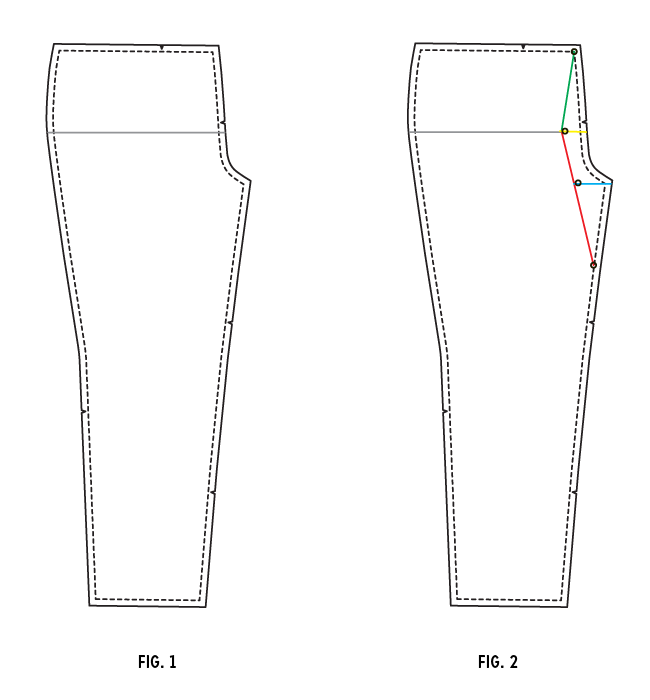
This is the sixth in a series of posts this week on different fitting adjustments you can use for the Clover sewalong, or for nearly any other pair of pants you make.
This tutorial is for those with a swayback. Swaybacks can be the result of your build, or just your posture. The pelvis tilts back toward the bottom, causing a pronounced curve in the lower back. The butt seems to stick out more. This causes a range of fitting issues, from fabric pooling at the lower back to stress at the crotch and butt. Let’s fix it!
Fitting notes:
- After you’ve made your muslin, please refer to the pants fitting cheatsheet to help you decide which adjustments to try.
- Use your muslin to determine how much to adjust the pattern. For example, if you can see that you need an extra inch of width in a certain area, you’ll need to add an inch of width when adjusting your pattern.
- Refer to this post on making muslins for further help with this.
- Be sure to make a second muslin (and perhaps more) after you’ve adjusted your pattern.
How to use the fitting diagrams:
- You will want to trace a copy of your pattern. Not a big deal, since this pattern has only a few pieces, and it will save you from ruining your pattern.
- Mark your seamlines on the pattern (5/8″ from the edge). You don’t need to mark it over the whole pattern, but at least mark the seam at the points where the slash lines are. On the diagrams, the seamlines are marked with dashed lines.
- The diagrams show where to cut, spread, and overlap your pattern.
- You’ll notice little circles in some spots, where the slash lines intersect the seam line. This is called a “pivot point.” Don’t slash the pattern all the way to the edge, but instead slash just to where this circle is. Then carefully snip into the seam allowance, forming a little hinge where the circle is. When you adjust your pattern, you’ll be pivoting at this point rather than from the very edge.
- Once you have your pieces adjusted, tape them into place. You can then retrace the pattern piece if you like.
Further help:
I’d love to help you as much as possible, but please realize there are a lot of you and only one of me. Please be sure to help each other out in the Flickr group as much as you can, and check out the fitting section of our Amazon store for further research.
Adjusting for a swayback

1. Draw in the hip line, as shown in grey in fig. 1. For this adjustment, you’ll working with both the front and back, so draw the hipline in on both pieces.
2. Draw in the slash lines on the pattern front, as shown in fig. 2.
3. Cut the pattern along these lines. Note the circles, which indicate where you will pivot the pattern. Cut a hinge here in the seam allowance rather than cutting all the way through to the edge (see notes above).

4. Spread the pattern front, as shown in fig. 3.

5. Now we’re going to work on the back. Draw in the slash lines, as shown in fig. 4.
6. Overlap along the green line, to reduce the length near the waist.
7. Spread at the red and yellow lines, to add width near the inseam and length around the full part of the butt.
8. Tape in place and retrace the pattern piece, smoothing out any lines that need it.



Comments
I’m sad that I don’t have the time currently to participate in the sew-along, but I’m so glad that I’ll have all these posts as a reference when I get around to making my own Clover pants later! I want a closet full of them– I love cigarette pants!
Thanks so much for this! I have swayback and fitting the waist it always a problem for me — I never thought to increase the front and below the waist. I hope to get started on my Clover muslin this week.
Thank you, thank you! I never knew how to fix this. Now I have to figure out how to correct for the pot belly with the sway back although I think the two are related. Everything scoops in the back and pushes forward.
Now I know why RTW pants never fit properly! They always gaped at the back in one size but size down couldn’t get past the hips. Glad to know I am not weird :)
I FINALLY have a muslin that I’m super happy with. I can not believe how much I altered my pattern, but I am so happy with it now. I added one inch to my swayback alteration, added one inch to the top of my back center line, and also made my back dart larger and one inch smaller, to pull in the back waist. So no more gaping back, woo hoo!
Sorry, I meant one inch smaller at the center back line, and expanded the dart to 1 1/4″.
Is there any way you could explain how you would adjust for a swayback in a top? I’m making a leotard without back seam and having real problems with wrinkling in the lower back!
Thanks
I can not find the sway front adjustments.
Swayfront? I am VERY curious about that adjustment. I have spent oodles of time in fitting books and online, and I haven’t heard of this. Will you be posting more info on this adjustment? I have been unsuccessful of totally ridding my pants of the pooling fabric below the buttocks and the flat bottom doesnt exactly match my anatomy
Love your posts. Been wrestling with a jeans pattern and can’t wait to try your method.
I am also very curious about the swayfront. I have always had the pooling of fabric below the buttox and don’t have a flat butt, do have slim legs though. Will be very interested to hear about the adjustment.